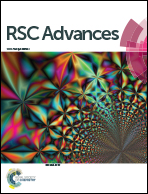Hydrothermal liquefaction of high protein microalgae via clay material catalysts†
Abstract
Hydrothermal liquefaction (HTL) is a promising method to convert wet microalgae into a petroleum-like biocrude. In this paper, we demonstrated the HTL of microalgae Spirulina over various clay material catalysts and open up interesting perspectives for efficiently liquefaction processes. The clay catalyst successfully improved the biocrude yield, the liquefaction conversion, and energy recovery. Investigation into optimizing operation conditions suggested that the reaction temperature and holding time significantly influenced the HTL process. The highest biocrude yields were obtained at a reaction temperature within the range of 220–250 °C and a holding time of 30 min with montmorillonite (46.56%), kaolinite (44.07%) and dolomitic limestone (46.35%). Adding clay catalysts changed the element content and produced more asphaltene content in the biocrude. The GC-MS analysis revealed that the catalyst greatly influenced the composition of the hydrocarbons, acids, esters, amides and heterocyclic compounds in the biocrude.



 Please wait while we load your content...
Please wait while we load your content...